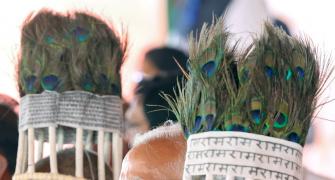![]() Founded in 1994, this is the Tiger Temple, or Wat Pha Luang Ta Bua Yanasampanno, a Theravada Buddhist temple in western Thailand.
Founded in 1994, this is the Tiger Temple, or Wat Pha Luang Ta Bua Yanasampanno, a Theravada Buddhist temple in western Thailand.
The Tiger Temple in the western province of Kanchanaburi -- about 80 kilometre from Bangkok -- began life in 1999 when the first female cub was brought to Wat Pa Luangta Bua Yannasampanno, a Buddhist sanctuary, and was cared for by the monks.
Since then, it has evolved into a much larger wildlife haven and is now a major tourist attraction in Thailand.
Here’s a glimpse inside this ‘temple’.

The temple, which houses, around 100 tigers, is one of the few places in the world that allows visitors to touch the big, wild cats. Visitors to the sanctuary are made to sign a disclaimer before they are allowed to enter -- to ensure the temple does not get sued in case someone is attacked by a tiger -- and signs at the gate explain why the tigers are so used to human contact.
However, the TigerTemple has been dogged by controversy as it has grown as a tourist attraction.
Many online forums discussing the temple speak of the mistreatment of the animals and the illegal supply to the black market.

The temple has been forced to strenuously deny accusations that its big cat residents are sedated to allow tourists to have their pictures taken with them.
They say the reason the carnivores are so docile is because they have been hand-reared by the monks from an early age, which means their aggressive behaviour has been controlled and they do not see human contact as a threat.
However, many remain suspicious over why the cats are so calm and sleepy during the visiting sessions.
“This is their home. They are happy here,” said Supitpong Pakdijarung, an official of the foundation that runs Wat Pa Luang Ta Bua, as the temple is known in Thailand.

“The government has to find a budget to take care of them,” Supitpong, the body’s deputy chairman, said. “Here, the money comes from donations. It is about giving and generosity.”
Supitpong denies accusations that tigers bred at the temple have been sold on the black market.
Despite the controversy, the vast majority of visitors walk away with a positive experience and a priceless photo.

The temple says that entrance fees go toward conservation efforts though the creation of TigerIsland, a giant enclosure, with tourist viewing points, where the cats will eventually be able to roam freely.
However, as critics are quick to point out, the project was started over four years ago, and is still nowhere near completion.








